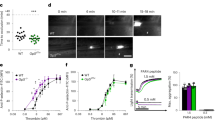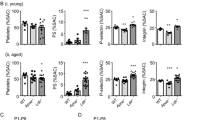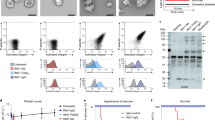Abstract
THE fibrinolytic potential of the vasculature is modulated primarily by the availability and activity of plasminogen activators, which convert the zymogen plasminogen into the active fibrin-degrading enzyme plasmin1. The activities of these key regulatory enzymes are directly neutralized by their primary endogenous inhibitor, plasminogen activator inhibitor-1 (PAI-1)2–6. Although some individuals with a tendency to develop thrombotic disorders exhibit elevated levels of PAI-1 in their plasma7–10, the cause-and-effect relationship between increased PAI-1 and thrombosis is still unclear. Specifically, it is not known whether chronic depression of fibrinolytic activity results in the development of thrombosis. To address this question we developed transgenic mice in which the contribution of PAI-1 to thrombus formation could be evaluated. The results presented in this report indicate that elevated levels of PAI-1 contribute to the development of venous but not arterial occlusions.
This is a preview of subscription content, access via your institution
Access options
Subscribe to this journal
Receive 51 print issues and online access
$199.00 per year
only $3.90 per issue
Buy this article
- Purchase on Springer Link
- Instant access to full article PDF
Prices may be subject to local taxes which are calculated during checkout
Similar content being viewed by others
References
Gaffney, P. J. Haemostasis and Thrombosis (eds Bloom, A. L. & Thomas, D. P.) 198–224 (Churchill Livingstone, Edinburgh, 1981).
Schleef, R. R. & Loskutoff, D. J. Haemostasis 18, 328–341 (1988).
Loskutoff, D. J. Sem. Thromb. Haemostasis 14, 100–109 (1988).
Erickson, L. A., Ginsberg, M. H. & Loskutoff, D. J. J. clin. Invest. 74, 1465–1472 (1984).
van Mourik, J. A., Lawrence, D. A. & Loskutoff, D. J. J. biol. Chem. 259, 14914–14921 (1984).
Kruithof, E. K. O., Tran-Thang, C. & Bachmann, F. Blood 70, 1645–1653 (1987).
Nilsson, I. M., Ljungner, H. & Tengborn, L. Br. med. J. 290, 1453–1456 (1985).
Paramo, J. A., Alfaro, M. J. & Rocha, E. Thromb. Haemostasis 54, 713–716 (1985).
Hamsten, A., Wiman, B., deFaire, U. & Blombäck, M. New Engl. J. Med. 313, 1557–1563 (1985).
Hamsten, A. et al. Lancet 2, 3–9 (1987).
Durnam, D. M. & Palmiter, R. D. J. biol. Chem. 256, 5712–5716 (1981).
Quaife, C., Hammer, R. E., Mottet, N. K. & Palmiter, R. D. Devl Biol. 118, 549–555 (1986).
Chakraborty, T. & Biswas, B. B. Biochem. biophys. Res. Commun. 147, 226–233 (1987).
Horellou, M. H., Conard, J., Bertina, R. M. & Samama, M. Br. med. J. 289, 1285–1287 (1984).
Declerck, P. J. et al. J. biol. Chem. 263, 15454–15461 (1988).
Chomczynski, P. & Sacchi, N. Analyt. Biochem. 162, 156–159 (1987).
Author information
Authors and Affiliations
Rights and permissions
About this article
Cite this article
Erickson, L., Fici, G., Lund, J. et al. Development of venous occlusions in mice transgenic for the plasminogen activator inhibitor-1 gene. Nature 346, 74–76 (1990). https://doi.org/10.1038/346074a0
Received:
Accepted:
Issue Date:
DOI: https://doi.org/10.1038/346074a0
This article is cited by
-
The role of fibrinolysis in vascular diseases in UK biobank
Journal of Thrombosis and Thrombolysis (2023)
-
Bone marrow mesenchymal stem cell-derived exosomes promote plasminogen activator inhibitor 1 expression in vascular cells in the local microenvironment during rabbit osteonecrosis of the femoral head
Stem Cell Research & Therapy (2020)
-
Surface modification of PVDF using non-mammalian sources of collagen for enhancement of endothelial cell functionality
Journal of Materials Science: Materials in Medicine (2016)
-
The role of plasminogen activator inhibitor 1 in renal and cardiovascular diseases
Nature Reviews Nephrology (2009)
-
Inhibition of plasminogen activator inhibitor-1 expression in vascular smooth muscle cells by protoporphyrins through a heme oxygenase-independent mechanism
Molecular and Cellular Biochemistry (2008)
Comments
By submitting a comment you agree to abide by our Terms and Community Guidelines. If you find something abusive or that does not comply with our terms or guidelines please flag it as inappropriate.



